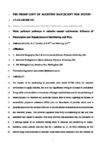Metal pollutant pathways in cohesive coastal catchments: Influence of flocculation and biopolymers on partitioning and flux
| dc.contributor.author | Schindler, Robert | |
| dc.contributor.author | Comber, Sean | |
| dc.contributor.author | Manning, Andrew | |
| dc.date.accessioned | 2021-08-09T10:19:34Z | |
| dc.date.issued | 2021-11-15 | |
| dc.identifier.issn | 0048-9697 | |
| dc.identifier.issn | 1879-1026 | |
| dc.identifier.other | 148800 | |
| dc.identifier.uri | http://hdl.handle.net/10026.1/17431 | |
| dc.description.abstract |
The impacts of the partitioning of potentially toxic metals (PTM) within the estuarine environment is highly complex, but is of key significance owing to increases in populations living within such sensitive environments. Although empirical data exist for the partitioning of metals between the dissolved and particulate phases, little is known regarding the impacts of extracellular polymeric substances (EPS) upon the flocculation of particles within such a dynamic system nor the resultant influence on the distribution of metals between the particulate and dissolved phases. This prevents regulators from fully understanding the fate and risks associated with metals in estuaries. This study provides data associated with the simulation of 3 settlings typical of the turbulent mixing found in estuaries and partitioning of copper, cadmium, nickel, arsenic, lead and zinc for 3 salinities (0, 15, 30 PSU) reflecting the full salinity range from freshwater to seawater. Experiments were completed with and without the presence of EPS, using kaolin as the mineral particulate. The results showed significant differences between salinity, PTMs and turbulence for the experiments with and without EPS present. Overall, salinity was the main factor controlling the PTM partitioning to sediment, however the flocculation process did impact on the PTM distribution and with the addition of EPS the impact was more pronounced. The data highlighted the importance of taking account of EPS within any estuarine sediment process modelling, for relying on simple partitioning with corrections for salinity would likely lead to significant bias. | |
| dc.format.extent | 148800-148800 | |
| dc.format.medium | Print-Electronic | |
| dc.language | en | |
| dc.language.iso | en | |
| dc.publisher | Elsevier | |
| dc.subject | Potentially toxic metals | |
| dc.subject | Partitioning | |
| dc.subject | Flocculation | |
| dc.subject | EPS | |
| dc.subject | Salinity | |
| dc.title | Metal pollutant pathways in cohesive coastal catchments: Influence of flocculation and biopolymers on partitioning and flux | |
| dc.type | journal-article | |
| dc.type | Journal Article | |
| plymouth.author-url | https://www.webofscience.com/api/gateway?GWVersion=2&SrcApp=PARTNER_APP&SrcAuth=LinksAMR&KeyUT=WOS:000697003500002&DestLinkType=FullRecord&DestApp=ALL_WOS&UsrCustomerID=11bb513d99f797142bcfeffcc58ea008 | |
| plymouth.volume | 795 | |
| plymouth.publication-status | Published | |
| plymouth.journal | Science of the Total Environment | |
| dc.identifier.doi | 10.1016/j.scitotenv.2021.148800 | |
| plymouth.organisational-group | /Plymouth | |
| plymouth.organisational-group | /Plymouth/Faculty of Science and Engineering | |
| plymouth.organisational-group | /Plymouth/Faculty of Science and Engineering/School of Biological and Marine Sciences | |
| plymouth.organisational-group | /Plymouth/Faculty of Science and Engineering/School of Geography, Earth and Environmental Sciences | |
| plymouth.organisational-group | /Plymouth/REF 2021 Researchers by UoA | |
| plymouth.organisational-group | /Plymouth/REF 2021 Researchers by UoA/UoA06 Agriculture, Veterinary and Food Science | |
| plymouth.organisational-group | /Plymouth/REF 2021 Researchers by UoA/UoA07 Earth Systems and Environmental Sciences | |
| plymouth.organisational-group | /Plymouth/Research Groups | |
| plymouth.organisational-group | /Plymouth/Research Groups/BEACh | |
| plymouth.organisational-group | /Plymouth/Research Groups/Marine Institute | |
| plymouth.organisational-group | /Plymouth/Users by role | |
| plymouth.organisational-group | /Plymouth/Users by role/Academics | |
| dc.publisher.place | Netherlands | |
| dcterms.dateAccepted | 2021-06-28 | |
| dc.rights.embargodate | 2022-7-3 | |
| dc.identifier.eissn | 1879-1026 | |
| dc.rights.embargoperiod | Not known | |
| rioxxterms.versionofrecord | 10.1016/j.scitotenv.2021.148800 | |
| rioxxterms.licenseref.uri | http://www.rioxx.net/licenses/all-rights-reserved | |
| rioxxterms.licenseref.startdate | 2021-11-15 | |
| rioxxterms.type | Journal Article/Review |


